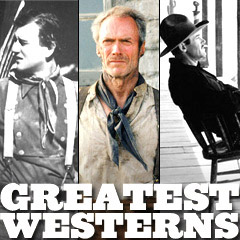
|
Greatest Westerns 1940s |
| Film Title/Year/Director/Length/Studio, Setting (or Time Period) and Brief Description | |
The Westerner (1940)
An offbeat fictionalized western, with fabled film star Walter Brennan as notorious, self-appointed, despotic hanging Judge Roy Bean (and winning his third Best Supporting Actor Oscar) and Gary Cooper as horse-stealing saddle tramp Cole Hardin. The story was told in the era of vicious range wars between cattlemen and homesteaders in the post-Civil War period. Included an impressive Gregg Toland-filmed prairie fire sequence. Hardin was on trial charged with horse theft - circumvented when he learned of Bean's obsession with English stage actress Lily Langtry (Lilian Bond). |
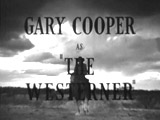
|
The Outlaw (1943)
An infamous sex-western salaciously marketed to full effect. Obsessed millionaire director/producer Howard Hughes' B-grade, much-censored film was notorious for leering camera views of star Jane Russell's ample cleavage (in her breakthrough debut film). The storyline, the pursuit of Billy the Kid by Sheriff Pat Garrett (Thomas Mitchell), with Jane Russell as Doc Holliday's (Walter Huston) sexy, half-breed mistress Rio (with an oft-unbuttoned, low-cut peasant blouse), was considered too racy for contemporary audiences in 1941 and postponed until 1943 for limited release. After a one-week run, Hughes shelved the film for three years after which it was finally placed in general release in 1946 (in a cut version), and again in 1947. |

|
The Ox-Bow Incident (1943)
Received only one Academy Award nomination - for Best Picture (a rarity among Best Picture nominees that usually received multiple nominations). Basically a poignant, somber morality-play and western with social commentary regarding vigilante justice. The film was the inspiration for Sidney Lumet's courtroom drama 12 Angry Men (1957). The thought-provoking indictment of blood-thirsty mob rule in the noirish film (filmed on studio sound sets) starred Henry Fonda and Harry Morgan as drifters Gil Carter and Art Croft, who attempted - unsuccessfully - to prevent the lynching of three innocent men for alleged murder and cattle rustling. Famed for Fonda's letter-reading of the farewell words of rancher Donald Martin (Dana Andrews), one of the lynched victims - an epitaph to the dead man's wife. |

|
Duel in the Sun (1946)
Critically nicknamed "Lust in the Dust" by its detractors, although it still remains one of the top box-office westerns - in inflation-adjusted dollars. The ambitious scandalous production from David O. Selznick was a "Gone With The Wind"- type grand western. This lurid Technicolor western, directed by King Vidor (who quit and was one of eight directors and cinematographers), was a sprawling melodramatic saga of sexual longing that was forced to cut nine minutes of its content before widespread release. Jennifer Jones starred as 'half-breed' Pearl Chavez caught in a destructive love triangle between the two sons of cattle baron family, crippled Senator Jackson and long-suffering Laura Belle McCanles (Lionel Barrymore and Lillian Gish): (1) Joseph Cotten as moderate and cultured Jesse, and (2) Gregory Peck as hot-tempered, amoral Lewt, both Cain and Abel archetypes. In the violent orgiastic, melodramatic ending, Pearl and Lewt shot each other to the death at Squaw's Head Rock and died in each other's arms. |
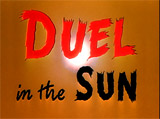
|
My
Darling Clementine (1946)
Noted for not being entirely historically accurate (in its telling of the Wyatt Earp and OK Corral legends) and for being highly romanticized, although the film's theme was the coming of civilization to the West. Shot in Arizona's Monument Valley. The story focused on frontier marshal Wyatt Earp (Henry Fonda), tubercular gambler/saloon owner Doc Holliday (Victor Mature), the object of Earp's affections (and Holliday's ex) - aristocratic East coaster Clementine Carter (Cathy Downs), and floozy saloon singer Chihuahua (Linda Darnell). Fonda, a superb character actor, portrayed the life of the legendary Earp - an independent, drifter cowboy and ex-marshal of Dodge City who became a responsible lawman in Tombstone - a rough frontier outpost (with raucous saloons) transformed into a civilized, law and order community settlement (with a church, a school and new schoolmarm Clementine, and even a traveling drunken Shakespearean actor (Alan Mowbray) performing in a saloon). |
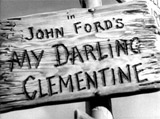
|
Pursued (1947)
A noirish, melodramatic psychological western was told mostly in flashback, and noted for cinematographer James Wong Howe's film-noir chiaroscuro (black and white) photography and Max Steiner's musical score. Robert Mitchum starred in an early role (his first lead role) as anti-hero, orphaned Jeb Rand, "pursued" by a haunted past (highlighted by nightmares of boots with jangling spurs and flashes of light, seen in flashbacks to the 1880s). He had witnessed the murder of his entire family as a young boy by a mysterious stranger, and suffered from repressed memories. [Note: There appeared to be a long-running feud between two families - the Rand family, and the Callum family.] Adopted by widowed "Ma" Callum (Judith Anderson), he grew up with two step-siblings - "Ma" Callum's biological daughter Thorley (Thor) Callum (Teresa Wright), and her son - the competitive, antagonistic Adam Callum (John Rodney). The main "pursuit" in the film was by villainous, one-armed county prosecutor Grant Callum (Dean Jagger), Ma Callum's vengeful brother-in-law who despised the Rand family and sole survivor Jeb. Grant continually baited others to bring Jeb down. There were two coin tosses that decided Jeb's fate - both of which were lost by Jeb. He was forced to volunteer to fight in the Spanish-American War, and he also was compelled to give up the Callum ranch to his step-brother Adam. Soon after, Jeb was forced to defend himself against Adam during an ambush, and he killed him in self-defense. He fell in love with Thor despite the fact that they were almost siblings. They married on the hidden pretext that she would kill him on their wedding night. Instead, she couldn't carry through on her promise and vowed her love instead. Grant also prodded local boy Prentice McComber (Harry Carey, Jr.) to challenge Jeb to a gunfight in a dark stable - when Jeb shot and killed the boy. The climactic revelation was that Grant was responsible for killing all the members of the Rand family, including Jeb's father, brother, and sister. The true nature of the precipitating bitter feud with the Rand family was revealed. Grant Callum had revenge obsessions because: (1) Jeb's father had murdered his brother, and (2) "Ma" Callum, the former wife of Grant's murdered brother, also had an incestuous affair with Jeb's father. Finally, during a climactic violent shootout with Grant, Jeb was forced to surrender and was about to be hanged. However, in the therapeutic ending, he was saved when Ma shot Grant. She atoned for her actions in the past, told Jeb about the true nature of the forces opposing him, assured him that his childhood trauma was over, and saved the young married couple. |
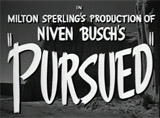
|
Fort Apache (1948)
The first of John Ford's three-part cavalry stories, it was followed by She Wore a Yellow Ribbon (1949) and Rio Grande (1950). RKO's picture (hurriedly completed in 3 weeks and $700K under budget) was set in the post-Civil War period at Fort Apache, an isolated cavalry post in Apache Territory in Arizona. In a reworking of the Custer myth about the flawed military character, John Wayne starred as veteran war Captain Kirby York stationed at the desolate Fort Apache, who soon found himself at odds with arrogant, stuffy, Indian-hating, racist lieutenant Lt. Col. Owen Thursday (Henry Fonda). The new replacement commander for Capt. Sam Collingwood (George O'Brien) was accompanied by his daughter Philadelphia (Shirley Temple in one of her first adult roles). A minor distracting sublot concerned a romance between Philadelphia and Lt. Mickey O'Rourke (John Agar), the son of Fort Apache non-commissioned veteran Sgt. Michael O'Rourke (Ward Bond). A disgruntled widower who resented being demoted after the Civil War and transferred to the West, the stubborn and by-the-book Lt. Thursday was ignorant about the local Native-Americans. He attempted to destroy honorable, clever and elusive Apache chief Cochise (Miguel Inclan) after luring him across the border from Mexico to return to the reservation, highlighted by a suicidal Army attack (symbolic of blundering "Custer's Last Stand"). Afterwards, "Thursday's Charge" was fictionally trumped up as heroic and courageous by the Eastern press, with York (who had assumed command of Fort Apache) loyally assenting to the glorified account of the battle. |
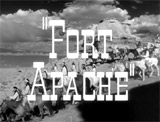
|
Red
River (1948)
A classic and complex epic western (and considered by many critics to be one of the ten best westerns ever made), and the first western from director Hawks. A sweeping story, similar to Mutiny on the Bounty, about a three-month cattle drive (historically based on the opening of the Chisholm Trail in 1867) and a film of generational rivalry and rebellion between a son and father, spanning a time period of fifteen years. With John Wayne as ruthless, strong-willed, bitter and contemptible Tom Dunson and Montgomery Clift (in his first film) as his less harsh, surrogate, adopted son Matthew. By film's conclusion, the cattle herd was successfully brought to market on the new Chisholm Trail, and the two men were reconciled after a brutal brawl, arbitrated by Tess Millay (Joanne Dru). |
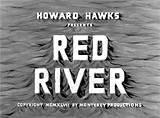
|
3 Godfathers (1948)
Ford's Technicolored remake (with Winton Hoch's superb cinematography) of the silent film The Three Godfathers (1916), which starred Ford's long-time friend Harry Carey, now used Carey's son as the character of William, aka The Abilene Kid. Ford's film (his first Technicolored film) was a heavy-handed tale of redemption - and a western retelling of the Biblical Three Wise Men tale. It was the precursor of the comedy, Three Men and a Baby (1987), and the Japanese anime film, Tokyo Godfathers (2003, Jp.). John Wayne starred as Robert Marmaduke Hightower, one of three "godfather" fugitive bank-robbing outlaws. In the film's opening moments, the trio robbed a small bank in the town of Welcome, Arizona, and were immediately pursued by local sheriff Perley "Buck" Sweet (Ward Bond) and his posse of deputies. They escaped from town, although William Kearney, the Abilene Kid (Harry Carey Jr.), was shot in the shoulder and wounded. Soon, the group of desperate cowboys was running low on water (their waterbag had been pierced with a bullet), had lost one horse, and were facing long stretches of desert, and a fierce sandstorm. The Sheriff strategically placed his men at each watering station, making it impossible for them to refuel. During their trek, the men came upon an abandoned wagon at Terrapin Wells (where the water tank had been dynamited) - and found a dying expectant mother (Mildred Natwick). [Note: She was actually the niece of the Sheriff.] She was assisted in the birth of the newborn baby boy, named Robert William Pedro (named after the three men, and allegorically the Christ child), and then she asked that the men accept "godfather" responsibilities for the soon-to-be orphaned child before she died. They buried her, and then continued to evade pursuit, by following a bright star in the sky. All they had was a baby-care book, cans of condensed milk, a Bible, some baby clothes and a baby bottle. The group of bandits fled with the baby through the desolate Arizona desert (filmed in Death Valley) toward the town of New Jerusalem, vowing redemptively to protect the innocent child while pursued. The Abilene Kid was the first to succumb to the heat, exhaustion and dehydration, due to his shoulder wound during the robbery. The second to die was Pedro or "Pete" (Pedro Armendariz), who fell and broke his leg, and committed suicide (off-screen). Robert was the sole survivor of the trek who was able to make it to the town of New Jerusalem, after he had hallucinated his friends encouraging him to continue on, and miraculously discovered a stray donkey. Robert staggered into a saloon in New Jerusalem on Christmas Day, where he was on the verge of collapse. He entered the bar, placed the baby on the counter, greeted everyone: "Merry Christmas to all," and ordered: "Set 'em up, bartender, milk for the infant, and a cool, cool beer for me." Moments later, the Sheriff charged in and apprehended Robert, who fell to the floor. He was viewed as a hero in the town of Welcome for saving the child. After a trial was held, the judge (Guy Kibbee) sentenced him to a minimum prison sentence of one year and one day after he vowed to continue caring for the baby, even after his release. In the meantime, the child would be cared for by his relatives (Uncle Buck and wife Mrs. Sweet (Mae Marsh)). |
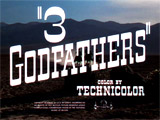
|
The
Treasure of the Sierra Madre (1948)
A classic tale of the elusive search for gold in the Sierra Madre Mountains by a trio of ill-matched prospectors who met in Tampico, Mexico. An intense character study showing the corruptive and cancerous effects of greed on the souls of men, including Humphrey Bogart as paranoid, vicious, and murderous gold-prospector Fred C. Dobbs and director John Huston's father Walter as a crazy but sage old prospector named Howard. The Hustons (John and father Walter) received the film's three Academy Awards - out of four nominations: Best Supporting Actor (Walter Huston with his sole Oscar win after three previous losses), Best Director (John Huston), and Best Screenplay (John Huston). Its sole losing nomination was for Best Picture (it lost to Laurence Olivier's Hamlet). Noted for repeated instances of the spoofed line: "Badges? We ain't got no badges! We don't need no badges. I don't have to show you any stinkin' badges!" |
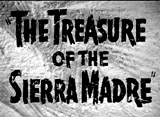
|
Yellow Sky (1948)
Screenwriter Lamar Trotti based his screenplay on a novel by W.R. Burnett - the stark b/w film was thought to have parallels to William Shakespeare's The Tempest. Bank-robber outlaw leader James "Stretch" Dawson (Gregory Peck) led his gang - including the menacing Dude (Richard Widmark) - to the frontier ghost town of Yellow Sky in the year 1867, as the film opened. They were on the run from a cavalry regiment after robbing the bank in Rameyville, and they wished to resupply with water and food for only a few days. There were only two residents in the deserted town: an elderly prospector named Grandpa (James Barton) and his attractive, gun-toting, forthright, Apache-raised grand-daughter Constance May (nicknamed "Mike") (Anne Baxter), Stretch's soon-to-be love-interest. During their stay in the town, Stretch learned that Mike and Grandpa were mining gold in the foothills and forced the two to make a fifty-fifty deal. Mike refused to cooperate, although Grandpa offered to split $50,000 in gold that they had buried in a mine shaft entrance. Major dissensions, hostilities and greed entered into the action when gold-crazy, double-crossing Dude refused to accept the deal and wished to claim the gold for himself. Dude shot and wounded Stretch, and after additional shoot-outs between gang-members, Dude lay dead. After healing, Stretch was redeemed - he and two of his gang members returned the stolen bank money at Rameyville. |
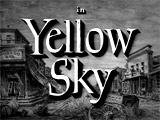
|
She Wore a Yellow Ribbon (1949)
The second of Ford's "Cavalry Trilogy" and the director's personal favorite of the three (preceded by Fort Apache (1948) and followed by Rio Grande (1950) which were in black and white). Noted for gorgeous Technicolor Oscar-winning cinematography by Winton C. Hoch (the film's sole nomination and win), and filmed in his favorite scenic locale - Monument Valley. An autumnal and sentimental western in which John Wayne played retirement-age cavalry Captain Nathan Cutting Brittles, serving at Fort Starke, a one-troop cavalry post, in 1876. His final goal was to prevent a large-scale Indian uprising following the Battle of the Little Big Horn that massacred Custer and his men of the 7th Cavalry. In one sunset scene, soon-to-be retired Capt. Brittles sat at the gravestone of his wife Mary Cutting Brittles and spoke to her while he watered the flowers. Brittles took a last patrol and dangerous mission to protectively accompany two women being evacuated from the post for their own safety to an awaiting stagecoach at Sudros Well: post commander Major Allshard's (George O'Brien) wife Abby 'Old Iron Pants' Allshard (Mildred Natwick), and attractive single lady Olivia Dandridge (Joanne Dru) (with a 'yellow ribbon' in her hair signifying she had chosen a beau) - who was being pursued by two lieutenants at the fort: Lieutenant Flint Cohill (John Agar) and Lieutenant Pennell (Harry Carey, Jr.). During the trip, Captain Brittles learned that warring Indians had destroyed the stage depot, forcing them to return to the fort. On his last day in a farewell scene, Brittles' C troops gave him a silver pocketwatch with the inscription "Lest we forget" that he tearfully and proudly read with his glasses. To avoid a bloody war, even after his retirement, Brittles chose a risky strategy of stampeding the Indians' horses out of their camp at midnight, to force them to return to their reservation on foot. |
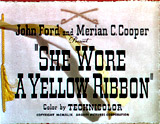
|
(chronological by film title) Introduction | Silents-1930s | 1940s | 1950-1955 | 1956-1959 | 1960-1965 1966-1969 | 1970s | 1980s-1990s | 2000s | 2010s |